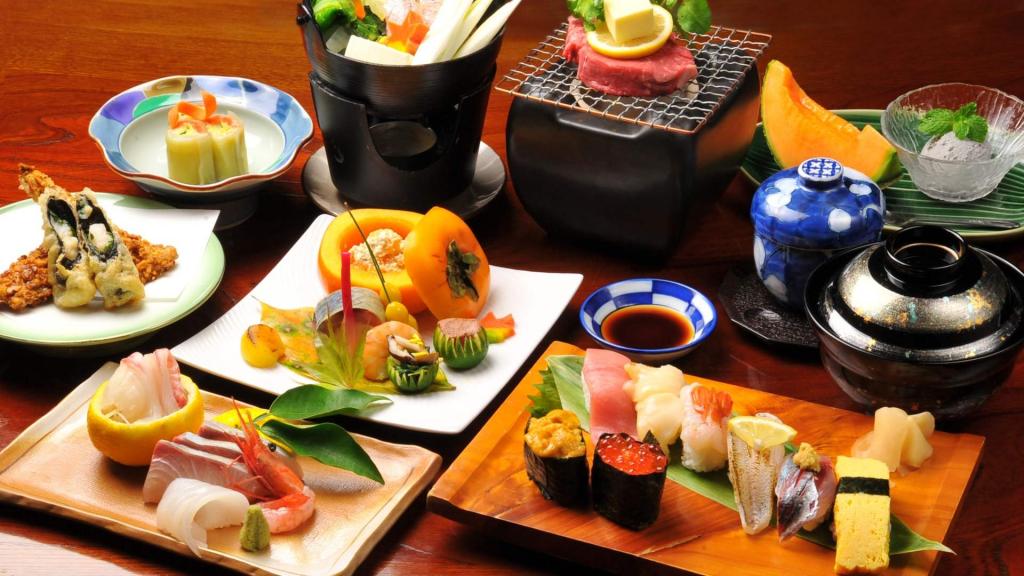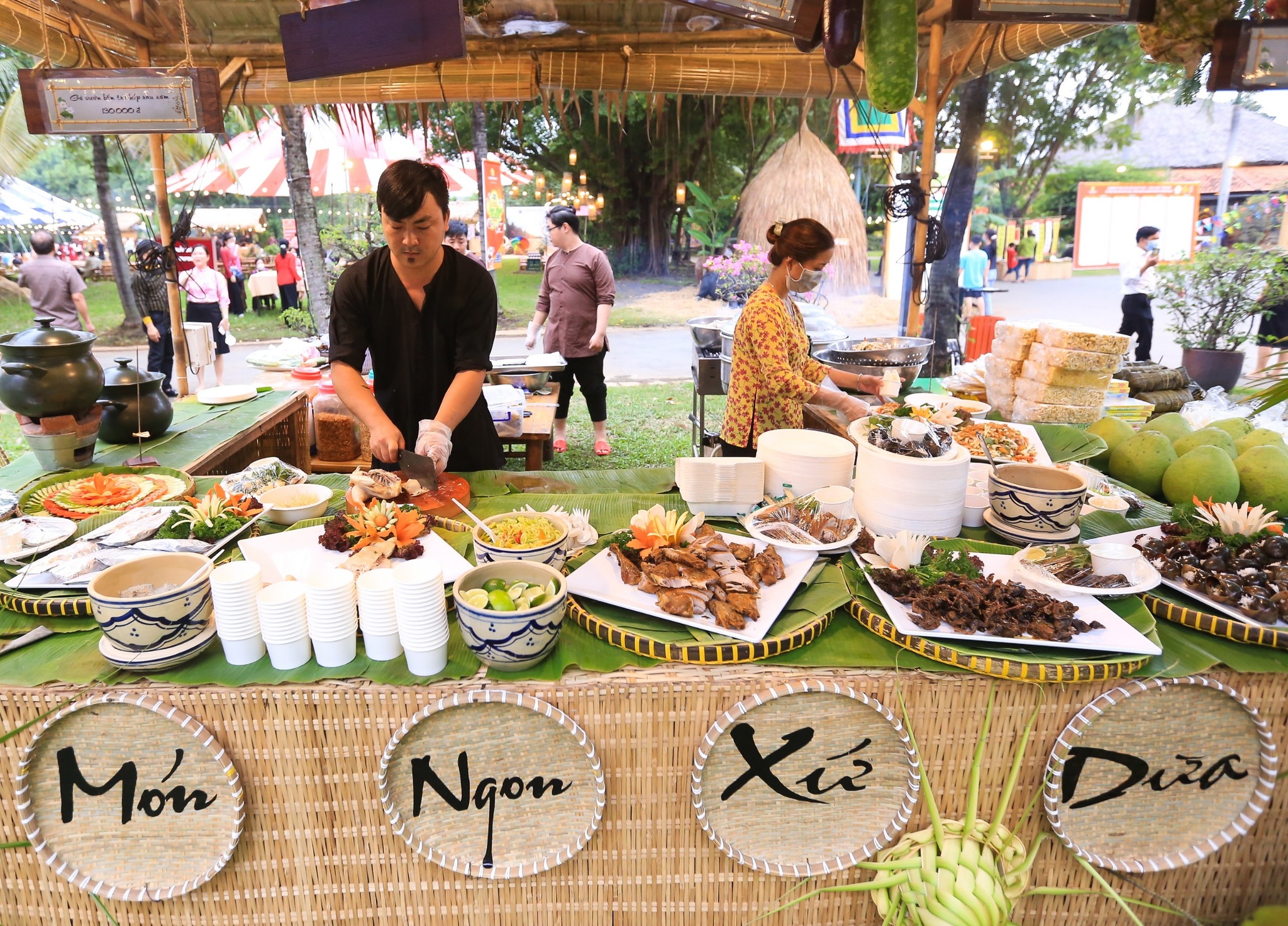No products in the cart.
Blog
Khám Phá Nền ẩm Thực Nhật Bản: Từ Gia đình đến Nhà Hàng
[

Khám Phá Nền ẩm Thực Nhật Bản: Từ Gia đình đến Nhà Hàng

Introduction:

Japan, a land of ancient traditions and modern marvels, boasts a culinary landscape as rich and diverse as its culture. From the humble home kitchen to the most exclusive Michelin-starred restaurants, Japanese food offers a journey for the senses, a symphony of flavors, textures, and presentations. This exploration delves into the heart of Japanese cuisine, unveiling its secrets and showcasing its evolution from family tables to sophisticated dining establishments. Prepare to be captivated by the subtleties and depth of this captivating culinary world.
Gia Đình: Nền Tảng của Ẩm Thực Nhật Bản
The heart of Japanese cuisine lies within the family home. Home cooking emphasizes fresh, seasonal ingredients, simple preparation methods, and a focus on balance and harmony. Family meals are a cornerstone of Japanese culture, fostering connection and tradition. The emphasis is not just on nourishment, but on the overall experience of sharing a meal together.
- Seasonal Ingredients: Japanese cuisine heavily relies on seasonal produce, ensuring the freshest flavors and peak nutritional value. This often dictates the menu, creating a dynamic culinary calendar.
- Rice as a Staple: Rice forms the foundation of most Japanese meals, symbolizing prosperity and abundance. Different types of rice are used depending on the region and the dish.
- Umami: The fifth taste, umami, plays a crucial role in Japanese cooking. It’s found in ingredients like soy sauce, kombu (kelp), and shiitake mushrooms, adding a savory depth to dishes.
- Simple Techniques: Japanese home cooking often involves simple yet elegant preparation methods that highlight the natural flavors of the ingredients. Minimal processing is preferred.
- Balance and Harmony: The presentation and balance of flavors, textures, and colors are crucial. Dishes often feature a combination of hot and cold, salty and sweet, and other contrasting elements.
- Family Recipes: Many families hold dear their recipes passed down through generations, adding a sentimental value to everyday meals.
Nhà Hàng: Sự Tinh Tế và Đổi Mới
While home cooking anchors Japanese cuisine, restaurants elevate it to an art form. From humble ramen shops to luxurious kaiseki restaurants, Japanese dining offers a wide spectrum of experiences and culinary styles. The focus shifts from simple home-style cooking to refined techniques, artistic presentations, and impeccable service.
- Kaiseki: Considered the pinnacle of Japanese haute cuisine, kaiseki is a multi-course meal showcasing the chef’s artistry and seasonal ingredients. Each dish is a miniature work of art.
- Sushi and Sashimi: These iconic dishes represent the pinnacle of Japanese seafood preparation, highlighting the freshness and quality of the ingredients. Expert knife skills are essential.
- Ramen: A beloved national dish, ramen is a hearty noodle soup with endless variations in broth, toppings, and noodles. It represents a comfort food enjoyed across all ages and social strata.
- Tempura: Lightly battered and deep-fried seafood and vegetables, tempura showcases a mastery of frying techniques, resulting in crispy, light, and flavorful bites.
- Izakaya: These informal pubs offer a relaxed atmosphere for enjoying a variety of small dishes (tapas-style) and alcoholic beverages. They’re perfect for socializing and sharing food.
- Regional Specialties: Japan’s diverse geography and culture have resulted in distinct regional cuisines, each boasting unique flavors, ingredients, and cooking styles.
Thành Phần Chính: Từ Biển đến Núi
Japanese cuisine’s foundation rests on its incredibly diverse ingredients. The ocean provides an abundance of fresh seafood, while the mountains yield an array of vegetables, mushrooms, and seaweed. The careful selection and use of these ingredients are integral to the success of any dish.
- Seafood: Japan is an island nation surrounded by abundant seafood, including sushi-grade tuna, salmon, mackerel, and a variety of shellfish.
- Rice: A staple grain, different types of rice are used depending on the dish and region. Short-grain rice is commonly used for sushi and steamed rice.
- Noodles: Various noodles, including soba (buckwheat), udon (wheat), and ramen noodles, add texture and flavor to many dishes.
- Vegetables: Japanese cuisine makes extensive use of vegetables, including daikon radish, kabocha squash, shiitake mushrooms, and a wide array of greens.
- Seaweed: Seaweed, such as nori (used for sushi) and wakame (used in soups), provides unique flavors and textures.
- Soy Products: Soy sauce, miso paste, and tofu are essential ingredients, adding umami and protein to many dishes.
Văn Hóa Ăn Uống: Nghi Lễ và Lịch Sự
The Japanese dining experience extends beyond the food itself; it’s deeply rooted in cultural etiquette and traditions. Understanding these customs enhances the overall experience and demonstrates respect for Japanese culture.
- Chopsticks Etiquette: Proper chopstick usage is essential. Avoid sticking chopsticks upright in rice, passing food directly from chopsticks to chopsticks, and using them to point.
- Slurping Noodles: Slurping noodles, especially ramen, is considered a sign of appreciation and enjoyment. It’s a demonstration of how much you’re enjoying the meal.
- Bowing: Bowing is a common greeting and a sign of respect. A slight bow is sufficient in most casual settings.
- Sharing Dishes: Many dishes are designed to be shared, encouraging communal eating and interaction.
- Saying “Itadakimasu” and “Gochisōsama deshita”: These phrases are respectively said before and after a meal as expressions of gratitude for the food and the effort that went into preparing it.
- Removing Shoes: In many traditional restaurants and homes, it’s customary to remove your shoes before entering.
Sự Phát Triển của Ẩm Thực Nhật Bản: Từ Truyền Thống Đến Hiện Đại
Japanese cuisine is not static; it’s a dynamic and evolving culinary tradition. While respecting its rich history, modern chefs are constantly innovating, incorporating new ingredients and techniques while retaining the essence of Japanese culinary philosophy.
- Fusion Cuisine: Modern Japanese chefs are experimenting with fusion cuisine, blending traditional Japanese techniques and flavors with influences from other culinary traditions.
- Sustainable Practices: A growing emphasis on sustainability is evident in the use of locally sourced ingredients, responsible fishing practices, and reducing food waste.
- Molecular Gastronomy: Some chefs are employing molecular gastronomy techniques to explore new textures and presentations, adding a layer of artistic expression.
- International Recognition: The global popularity of Japanese cuisine has led to increased international recognition and the spread of Japanese culinary techniques and ingredients worldwide.
- Michelin Stars: The rise of Michelin-starred restaurants in Japan showcases the sophistication and artistry of Japanese haute cuisine.
- Food Tourism: Japan’s culinary landscape is becoming a major draw for food tourism, with people traveling to experience the country’s diverse regional cuisines.
Information in Table Form: Key Differences Between Home and Restaurant Cooking in Japan
| Feature | Home Cooking | Restaurant Cooking |
|---|---|---|
| Focus | Family, simplicity, tradition, seasonality | Artistic presentation, refined techniques, service |
| Ingredients | Fresh, seasonal, locally sourced | High-quality, often imported, seasonal |
| Preparation | Simple, straightforward | Complex, intricate, meticulous |
| Atmosphere | Intimate, casual | Formal, sophisticated, often thematic |
| Cost | Economical | Can range from moderate to extremely expensive |
| Experience | Comforting, familiar | Memorable, often a special occasion experience |
Conclusion:
From the warmth of the family table to the elegant sophistication of Michelin-starred restaurants, Japanese cuisine offers a captivating exploration of flavors, traditions, and culture. This culinary journey, from the simplicity of home cooking to the artistry of haute cuisine, reveals a rich tapestry woven with fresh ingredients, meticulous techniques, and a profound respect for culinary heritage. Whether you’re enjoying a bowl of ramen at a bustling Izakaya or savoring a delicate kaiseki meal, the experience is a testament to the enduring appeal and multifaceted nature of Japanese food. The balance, harmony, and subtle nuances create an unforgettable culinary adventure, making it one of the most celebrated cuisines in the world. So, embark on your own culinary voyage into the heart of Japan; you won’t be disappointed.
Keywords: Japanese Cuisine, Japanese Food, Kaiseki, Sushi, Ramen
]

Bài viết hay quá! Tôi thích cách tác giả trình bày, dễ hiểu và hấp dẫn lắm. Đọc xong muốn đặt vé đi Nhật ngay và luôn! Tuyệt vời!
Thật sự thất vọng! Nhiều thông tin quá chung chung, không có gì mới mẻ cả. Tôi đã mong đợi nhiều hơn từ bài viết này.
Thêm thông tin về giá cả các món ăn nha. Tôi thấy bài viết thiếu phần này. Cũng nên đề cập đến sự khác biệt giữa ẩm thực vùng này với vùng khác nữa.
Tôi không đồng ý với quan điểm của tác giả về sushi. Sushi không chỉ đơn giản là cá sống, nó là cả một nghệ thuật! Tác giả cần nghiên cứu kỹ hơn trước khi viết.
Ôi, khám phá nền ẩm thực Nhật Bản à? Tuyệt vời! Tôi đang đói đây này. (và bài viết thì… cũng được thôi)
Bài viết hay thật đấy! Hài hước vl, nhưng mà thông tin thì… chẳng có gì đáng giá cả. Thật là một sự kết hợp kỳ lạ!
Haha, đọc bài viết mà cười đau bụng luôn! Tác giả dí dỏm ghê, viết hay quá trời! Tuyệt vời ông mặt trời!
Bài viết rất chi tiết và đầy đủ thông tin. Tôi học được rất nhiều điều mới mẻ về ẩm thực Nhật Bản. Tuy nhiên, hình ảnh minh họa hơi ít.